Radar-Based Precipitation Climatology in Germany—Developments, Uncertainties and Potentials
Abstract
1. Introduction
- Which developments in the German radar-based QPE derivation procedure have taken place since the launch of the RADOLAN programme in 2006 and how did they affect data quality?
- How did the additional climatological correction algorithms used for RADKLIM affect the data quality compared to RADOLAN and the gauge dataset?
- Which challenges, advantages and limitations do users need to take into account when using RADKLIM and RADOLAN in comparison to gauge data?
2. Materials and Methods
2.1. Study Area
2.2. Data Basis
2.2.1. RADOLAN
- The elimination of clutter pixels;
- Orographic shading correction;
- Smoothing with gradient filters;
- A transformation of the reflectivity Z to rain rates R using a custom refined Z-R-relation;
- Merging the local radar station data to a national gridded composite;
- The adjustment of the radar-based rain rates to ground-truth automated rain gauge measurements using a weighted average of adjustment differences and factors [25].
2.2.2. RADKLIM
2.2.3. Rain Gauge Data
2.3. Methodology
2.3.1. Data Preparation
2.3.2. Dataset Completeness and Outliers
2.3.3. Precipitation Statistics and Interrelations to Potential Error Sources
2.3.4. Rainfall Detection and Intensity
3. Results
3.1. Spatiotemporal Distribution and Impacts of Outliers and Missing Data
3.2. Annual and Seasonal Precipitation Sums
3.3. Impacts of Elevation and Distance from Next Radar
3.4. Rainfall Detection Rates, Heavy Rainfall Days and Rainfall Intensities
4. Discussion
5. Conclusions
Author Contributions
Funding
Acknowledgments
Conflicts of Interest
References
- Global Climate Observing System (GCOS). The Global Observing System for Climate: Implementation Needs; WMO-Pub GCOS-200; GCOS: Geneva, Switzerland, 2016; Available online: https://unfccc.int/sites/default/files/gcos_ip_10oct2016.pdf (accessed on 14 February 2019).
- Kidd, C.; Becker, A.; Huffman, G.J.; Muller, C.L.; Joe, P.; Skofronick-Jackson, G.; Kirschbaum, D.B. So, how much of the Earth’s surface is covered by rain gauges? Bull. Am. Meteorol. Soc. 2017, 98, 69–78. [Google Scholar] [CrossRef] [PubMed]
- Lochbihler, K.; Lenderink, G.; Siebesma, A.P. The spatial extent of rainfall events and its relation to precipitation scaling. Geophys. Res. Lett. 2017, 44, 8629–8636. [Google Scholar] [CrossRef]
- Sun, X.; Mein, R.G.; Keenan, T.D.; Elliott, J.F. Flood estimation using radar and raingauge data. J. Hydrol. 2000, 239, 4–18. [Google Scholar] [CrossRef]
- Thorndahl, S.; Einfalt, T.; Willems, P.; Nielsen, J.E.; ten Veldhuis, M.-C.; Arnbjerg-Nielsen, K.; Rasmussen, M.R.; Molnar, P. Weather radar rainfall data in urban hydrology. Hydrol. Earth Syst. Sci. 2017, 21, 1359–1380. [Google Scholar] [CrossRef]
- Villarini, G.; Mandapaka, P.V.; Krajewski, W.F.; Moore, R.J. Rainfall and sampling uncertainties: A rain gauge perspective. J. Geophys. Res. 2008, 113. [Google Scholar] [CrossRef]
- Abon, C.C.; Kneis, D.; Crisologo, I.; Bronstert, A.; David, C.P.C.; Heistermann, M. Evaluating the potential of radar-based rainfall estimates for streamflow and flood simulations in the Philippines. Geomat. Nat. Hazards Risk 2015, 7, 1390–1405. [Google Scholar] [CrossRef]
- Cole, S.J.; Moore, R.J. Hydrological modelling using raingauge- and radar-based estimators of areal rainfall. J. Hydrol. 2008, 358, 159–181. [Google Scholar] [CrossRef]
- Hazenberg, P.; Leijnse, H.; Uijlenhoet, R. Radar rainfall estimation of stratiform winter precipitation in the Belgian Ardennes. Water Resour. Res. 2011, 47, 257. [Google Scholar] [CrossRef]
- Jessen, M.; Einfalt, T.; Stoffer, A.; Mehlig, B. Analysis of heavy rainfall events in North Rhine–Westphalia with radar and raingauge data. Atmos. Res. 2005, 77, 337–346. [Google Scholar] [CrossRef]
- Kitchen, M.; Blackall, R.M. Representativeness errors in comparisons between radar and gauge measurements of rainfall. J. Hydrol. 1992, 134, 13–33. [Google Scholar] [CrossRef]
- Meißner, D.; Gebauer, S.; Schumann, A.H.; Pahlow, M.; Rademacher, S. Analyse radarbasierter Niederschlagsprodukte als Eingangsdaten verkehrsbezogener Wasserstandsvorhersagen am Rhein. Hydrol. Und Wasserbewirtsch. Hywa 2012, 56, 16–28. [Google Scholar]
- Seo, B.-C.; Krajewski, W.F. Scale Dependence of Radar Rainfall Uncertainty: Initial Evaluation of NEXRAD’s New Super-Resolution Data for Hydrologic Applications. J. Hydrometeor 2010, 11, 1191–1198. [Google Scholar] [CrossRef]
- Satgé, F.; Ruelland, D.; Bonnet, M.-P.; Molina, J.; Pillco, R. Consistency of satellite-based precipitation products in space and over time compared with gauge observations and snow- hydrological modelling in the Lake Titicaca region. Hydrol. Earth Syst. Sci. 2019, 23, 595–619. [Google Scholar] [CrossRef]
- Crisologo, I.; Warren, R.; Mühlbauer, K.; Heistermann, M. Enhancing the consistency of spaceborne and ground-based radar comparisons by using quality filters. Atmos. Meas. Tech. Discuss. 2018, 1–20. [Google Scholar] [CrossRef]
- Ramsauer, T.; Weiß, T.; Marzahn, P. Comparison of the GPM IMERG Final Precipitation Product to RADOLAN Weather Radar Data over the Topographically and Climatically Diverse Germany. Remote Sens. 2018, 10, 2029. [Google Scholar] [CrossRef]
- Pejcic, V.; Tromel, S.; Muhlbauer, K.; Saavedra, P.; Beer, J.; Simmer, C. Synergy of GPM and ground-based radar observations for precipitation estimation and detection of microphysical processes. Int. Radar Symp. 2018, 1–8. [Google Scholar]
- Pejcic, V.; Saavedra Garfias, P.; Mühlbauer, K.; Troemel, S.; Simmer, C. Evaluation of Germany’s network radar Composite Rain Producs with GPM Near Surface Precipitation Estimations; Earth and Space Science Open Archive: San Francisco, CA, USA, 2019. [Google Scholar]
- Gilewski, P.; Nawalany, M. Inter-Comparison of Rain-Gauge, Radar, and Satellite (IMERG GPM) Precipitation Estimates Performance for Rainfall-Runoff Modeling in a Mountainous Catchment in Poland. Water 2018, 10, 1665. [Google Scholar] [CrossRef]
- Kidd, C.; Bauer, P.; Turk, J.; Huffman, G.J.; Joyce, R.; Hsu, K.-L.; Braithwaite, D. Intercomparison of High-Resolution Precipitation Products over Northwest Europe. J. Hydrometeor 2012, 13, 67–83. [Google Scholar] [CrossRef]
- Berne, A.; Krajewski, W.F. Radar for hydrology: Unfulfilled promise or unrecognized potential? Adv. Water Resour. 2013, 51, 357–366. [Google Scholar] [CrossRef]
- Kidd, C.; Levizzani, V. Status of satellite precipitation retrievals. Hydrol. Earth Syst. Sci. 2011, 15, 1109–1116. [Google Scholar] [CrossRef]
- Keupp, L.; Winterrath, T.; Hollmann, R. Use of Weather Radar Data for Climate Data Records in WMO Regions IV and VI; WMO: Geneva, Switzerland, 2017. [Google Scholar]
- Overeem, A.; Holleman, I.; Buishand, A. Derivation of a 10-Year Radar-Based Climatology of Rainfall. J. Appl. Meteor. Climatol. 2009, 48, 1448–1463. [Google Scholar] [CrossRef]
- Bartels, H.; Weigl, E.; Reich, T.; Lang, W.; Wagner, A.; Kohler, O.; Gerlach, N. MeteoSolutions GmbH: Projekt RADOLAN—Routineverfahren zur Online-Aneichung der Radarniederschlagsdaten Mit Hilfe Von Automatischen Bodenniederschlagsstationen (Ombrometer); Zusammenfassender Abschlussbericht für die Projektlaufzeit von 1997 bis 2004; DWD: Offenbach, Germany, 2004. [Google Scholar]
- Hänsel, P.; Kaiser, A.; Buchholz, A.; Böttcher, F.; Langel, S.; Schmidt, J.; Schindewolf, M. Mud Flow Reconstruction by Means of Physical Erosion Modeling, High-Resolution Radar-Based Precipitation Data, and UAV Monitoring. Geosciences 2018, 8, 427. [Google Scholar] [CrossRef]
- Bronstert, A.; Agarwal, A.; Boessenkool, B.; Crisologo, I.; Fischer, M.; Heistermann, M.; Köhn-Reich, L.; López-Tarazón, J.A.; Moran, T.; Ozturk, U.; et al. Forensic hydro-meteorological analysis of an extreme flash flood: The 2016-05-29 event in Braunsbach, SW Germany. Sci. Total Environ. 2018, 977–991. [Google Scholar] [CrossRef] [PubMed]
- Johann, G.; Ott, B.; Treis, A. Einfluss von terrestrisch gemessenen und radarbasierten Niederschlagsdaten auf die Qualität der Hochwasservorhersage. Korresp. Wasserwirtsch. 2009, 9, 487–493. [Google Scholar]
- Fischer, F.; Hauck, J.; Brandhuber, R.; Weigl, E.; Maier, H.; Auerswald, K. Spatio-temporal variability of erosivity estimated from highly resolved and adjusted radar rain data (RADOLAN). Agric. For. Meteorol. 2016, 223, 72–80. [Google Scholar] [CrossRef]
- Fischer, F.K.; Kistler, M.; Brandhuber, R.; Maier, H.; Treisch, M.; Auerswald, K. Validation of official erosion modelling based on high-resolution radar rain data by aerial photo erosion classification. Earth Surf. Process. Landf. 2018, 43, 187–194. [Google Scholar] [CrossRef]
- Winterrath, T.; Brendel, C.; Junghänel, T.; Klameth, A.; Lengfeld, K.; Walawender, E.; Weigl, E.; Hafer, M.; Becker, A. An overview of the new radar-based precipitation climatology of the Deutscher Wetterdienst—Data, methods, products. In Proceedings of the UrbanRain18, 11th International Workshop on Precipitation in Urban Areas, Urban Areas, Zürich, Switzerland, 5–7 December 2018. [Google Scholar]
- Lengfeld, K.; Winterrath, T.; Junghänel, T.; Becker, A. Characteristic spatial extent of rain events in Germany from a radar-based precipitation climatology. In Proceedings of the UrbanRain18, 11th International Workshop on Precipitation in Urban Areas, Urban Areas, Zürich, Switzerland, 5–7 December 2018. [Google Scholar]
- Fischer, F.K.; Winterrath, T.; Auerswald, K. Temporal- and spatial-scale and positional effects on rain erosivity derived from point-scale and contiguous rain data. Hydrol. Earth Syst. Sci. 2018, 22, 6505–6518. [Google Scholar] [CrossRef]
- Auerswald, K.; Fischer, F.K.; Winterrath, T.; Brandhuber, R. Rain erosivity map for Germany derived from contiguous radar rain data. Hydrol. Earth Syst. Sci. 2019, 23, 1819–1832. [Google Scholar] [CrossRef]
- Deutscher Wetterdienst Open Data Portal. Historische Stündliche RADOLAN-Raster der Niederschlagshöhe (Binär). Available online: https://opendata.dwd.de/climate_environment/CDC/grids_germany/hourly/radolan/historical/bin/ (accessed on 7 October 2019).
- Weigl, E. RADOLAN Information Nr. 13. Available online: https://www.dwd.de/DE/leistungen/radolan/radolan_info/radolan_info_nr_13.pdf?__blob=publicationFile&v=3 (accessed on 8 October 2019).
- Weigl, E. RADOLAN Information Nr. 15. Available online: https://www.dwd.de/DE/leistungen/radolan/radolan_info/radolan_info_nr_15.pdf?__blob=publicationFile&v=3 (accessed on 8 October 2019).
- Weigl, E.; Winterrath, T. Radargestützte Niederschlagsanalyse und—Vorhersage (RADOLAN, RADVOR-OP). Promet 2009, 35, 78–86. [Google Scholar]
- Weigl, E. RADOLAN-Information Nr. 17. Available online: https://www.dwd.de/DE/leistungen/radolan/radolan_info/radolan_info_nr_17.pdf?__blob=publicationFile&v=3 (accessed on 17 June 2019).
- Stephan, K. Erfahrungsbericht zur Verwendung des PULL-Kompositverfahrens zur Erstellung des Radolan-Komposits (RZ-Komposit). 2007; Unpublished work. [Google Scholar]
- Weigl, E. RADOLAN-Information Nr. 41. Available online: https://www.dwd.de/DE/leistungen/radolan/radolan_info/radolan_info_nr_41.pdf;jsessionid=65C71E4F45253E6B3CE3F24F443D3E2B.live11044?__blob=publicationFile&v=2 (accessed on 17 December 2019).
- Weigl, E. RADOLAN-Information Nr. 45. Available online: https://www.dwd.de/DE/leistungen/radolan/radolan_info/radolan_info_nr_45.pdf;jsessionid=65C71E4F45253E6B3CE3F24F443D3E2B.live11044?__blob=publicationFile&v=3 (accessed on 17 December 2019).
- Winterrath, T.; Brendel, C.; Hafer, M.; Junghänel, T.; Klameth, A.; Lengfeld, K.; Walawender, E.; Weigl, E.; Becker, A. Radar Climatology (RADKLIM) Version 2017.002 (RW). Gridded Precipitation Data for Germany; Available online: https://opendata.dwd.de/climate_environment/CDC/grids_germany/hourly/radolan/reproc/2017_002/bin (accessed on 25 June 2019).
- Winterrath, T.; Brendel, C.; Hafer, M.; Junghänel, T.; Klameth, A.; Lengfeld, K.; Walawender, E.; Weigl, E.; Becker, A. Radar Climatology (RADKLIM) Version 2017.002 (YW). Gridded Precipitation Data for Germany; Available online: https://opendata.dwd.de/climate_environment/CDC/grids_germany/5_minutes/radolan/reproc/2017_002/bin/ (accessed on 25 June 2019).
- Winterrath, T.; Brendel, C.; Hafer, M.; Junghänel, T.; Klameth, A.; Walawender, E.; Weigl, E.; Becker, A. Erstellung Einer Radargestützten Niederschlagsklimatologie. Berichte des Deutschen Wetterdienstes No. 251; 2017; Available online: https://www.dwd.de/DE/leistungen/pbfb_verlag_berichte/pdf_einzelbaende/251_pdf.pdf?__blob=publicationFile&v=2 (accessed on 29 March 2019).
- Deutscher Wetterdienst Open Data Portal. Rain Gauge Precipitation Observations in 1-Minute Resolution. Available online: https://opendata.dwd.de/climate_environment/CDC/observations_germany/climate/1_minute/precipitation/ (accessed on 10 January 2019).
- Kreklow, J.; Tetzlaff, B.; Kuhnt, G.; Burkhard, B. A Rainfall Data Intercomparison Dataset of RADKLIM, RADOLAN, and Rain Gauge Data for Germany. Data 2019, 4, 118. [Google Scholar] [CrossRef]
- Kreklow, J. Facilitating radar precipitation data processing, assessment and analysis: A GIS-compatible python approach. J. Hydroinformatics 2019, 21, 652–670. [Google Scholar] [CrossRef]
- Kreklow, J. Radproc—A Gis-Compatible Python-Package for Automated Radolan Composite Processing and Analysis; Zenodo: Geneva, Switzerland, 2018; Available online: https://zenodo.org/record/2539441 (accessed on 25 June 2019).
- Kreklow, J.; Tetzlaff, B.; Kuhnt, G.; Burkhard, B. A Rainfall Data Inter-Comparison Dataset for Germany: Version 1.0; Zenodo: Geneva, Switzerland, 2019; Available online: https://zenodo.org/record/3262172 (accessed on 29 June 2019).
- Tukey, J. Exploratory Data Analysis; Addison-Wesley: Boston, MA, USA, 1977. [Google Scholar]
- Deutscher Wetterdienst. Jahresrückblick 2007 des Deutschen Wetterdienstes. Gefährliche Wetterereignisse Und Wetterschäden in Deutschland; Offenbach am Main: Offenbach, Germany, 2007. [Google Scholar]
- Deutscher Wetterdienst. Jahresbericht 2016. 2017. Available online: https://www.dwd.de/DE/leistungen/jahresberichte_dwd/jahresberichte_pdf/jahresbericht_2016.pdf?__blob=publicationFile&v=3 (accessed on 18 December 2019).
- Grazioli, J.; Tuia, D.; Berne, A. Hydrometeor classification from polarimetric radar measurements: A clustering approach. Atmos. Meas. Tech. 2015, 8, 149–170. [Google Scholar] [CrossRef]
- Goudenhoofdt, E.; Delobbe, L. Generation and Verification of Rainfall Estimates from 10-Yr Volumetric Weather Radar Measurements. J. Hydrometeor 2016, 17, 1223–1242. [Google Scholar] [CrossRef]
- Fairman, J.G.; Schultz, D.M.; Kirshbaum, D.J.; Gray, S.L.; Barrett, A.I. A radar-based rainfall climatology of Great Britain and Ireland. Weather 2015, 70, 153–158. [Google Scholar] [CrossRef]
- Smith, J.A.; Baeck, M.L.; Villarini, G.; Welty, C.; Miller, A.J.; Krajewski, W.F. Analyses of a long-term, high-resolution radar rainfall data set for the Baltimore metropolitan region. Water Resour. Res. 2012, 48, 616. [Google Scholar] [CrossRef]
- Schleiss, M.; Olsson, J.; Berg, P.; Niemi, T.; Kokkonen, T.; Thorndahl, S.; Nielsen, R.; Nielsen, J.E.; Bozhinova, D.; Pulkkinen, S. The Accuracy of Weather Radar in Heavy Rain: A Comparative study for Denmark, the Netherlands, Finland and Sweden. Hydrol. Earth Syst. Sci. Discuss. 2019, 1–42. [Google Scholar] [CrossRef]
- Marra, F.; Morin, E. Use of radar QPE for the derivation of Intensity–Duration–Frequency curves in a range of climatic regimes. J. Hydrol. 2015, 531, 427–440. [Google Scholar] [CrossRef]
- Boudala, F.S.; Isaac, G.A.; Filman, P.; Crawford, R.; Hudak, D.; Anderson, M. Performance of Emerging Technologies for Measuring Solid and Liquid Precipitation in Cold Climate as Compared to the Traditional Manual Gauges. J. Atmos. Ocean. Technol. 2017, 34, 167–185. [Google Scholar] [CrossRef]
- Kochendorfer, J.; Rasmussen, R.; Wolff, M.; Baker, B.; Hall, M.E.; Meyers, T.; Landolt, S.; Jachcik, A.; Isaksen, K.; Brækkan, R.; et al. The quantification and correction of wind-induced precipitation measurement errors. Hydrol. Earth Syst. Sci. 2017, 21, 1973–1989. [Google Scholar] [CrossRef]
- Heistermann, M.; Kneis, D. Benchmarking quantitative precipitation estimation by conceptual rainfall-runoff modeling. Water Resour. Res. 2011, 47, 301. [Google Scholar] [CrossRef]
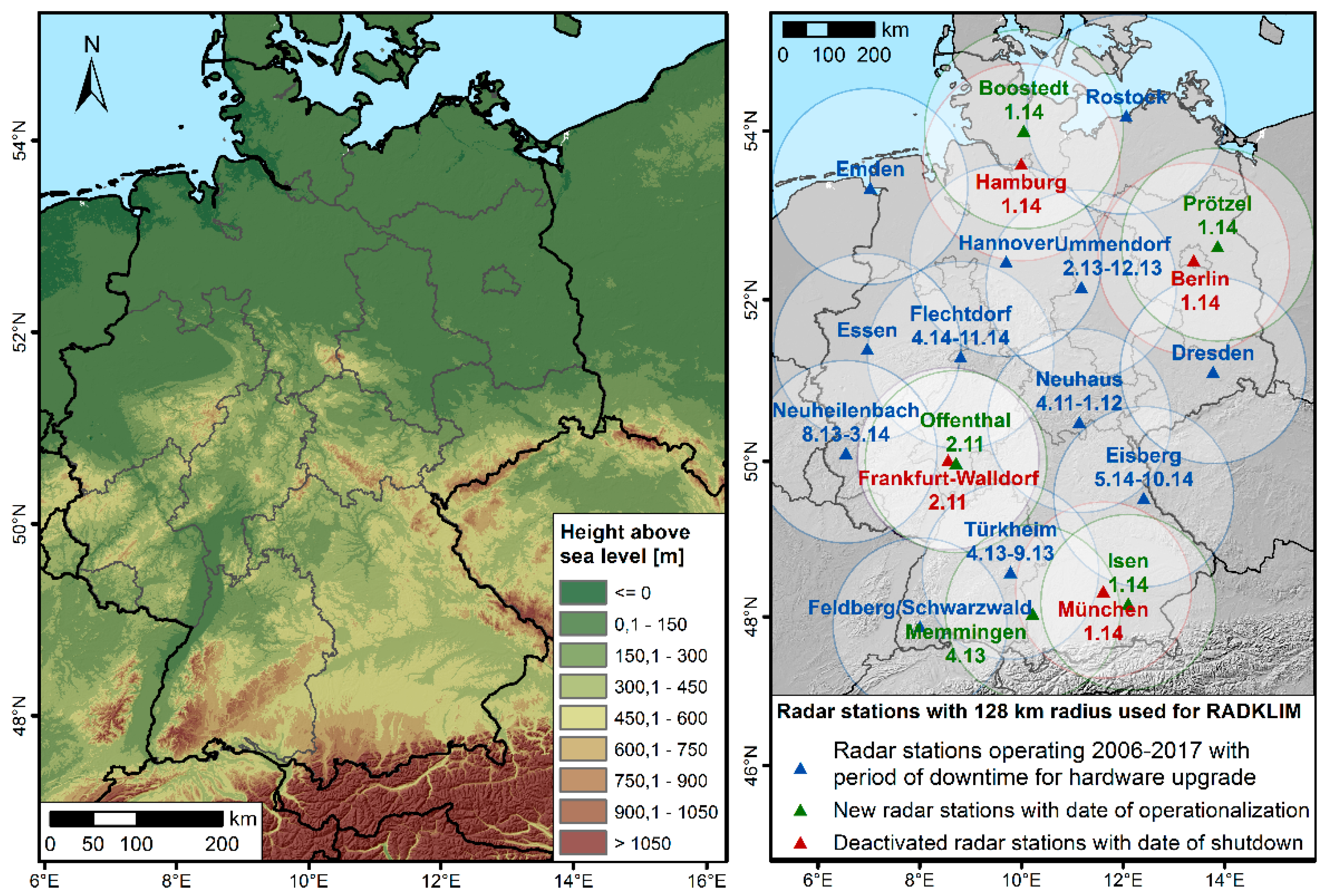
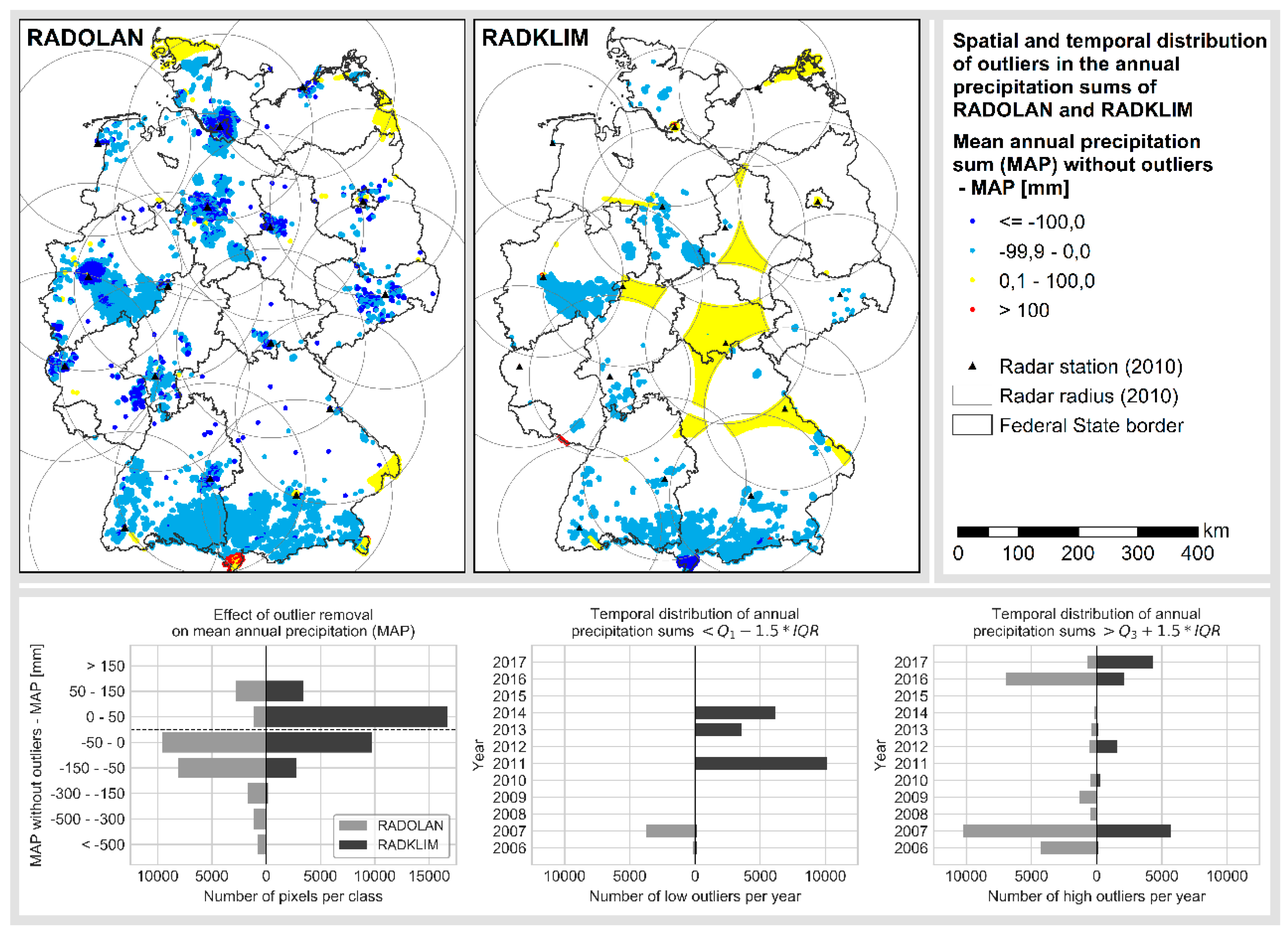
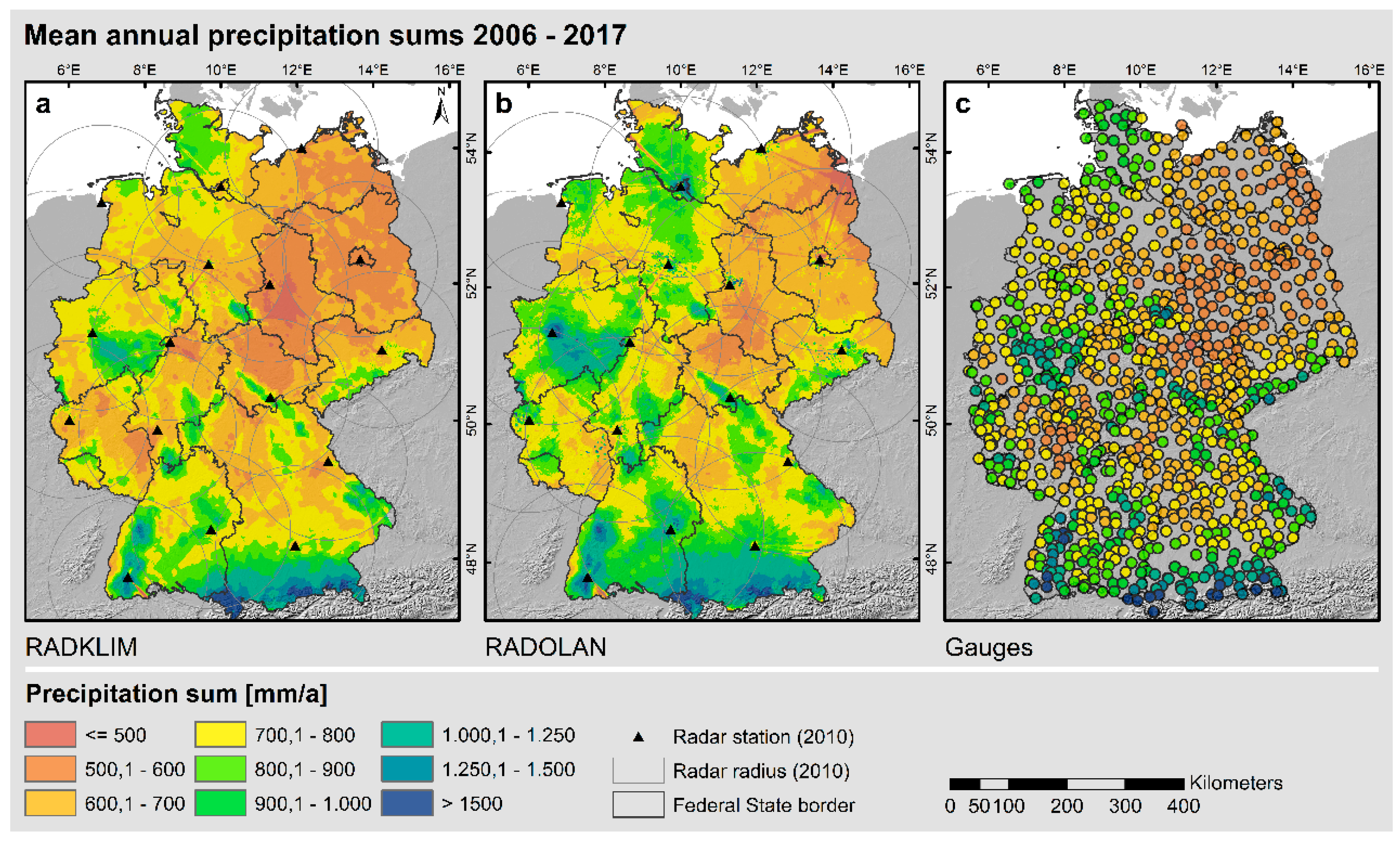
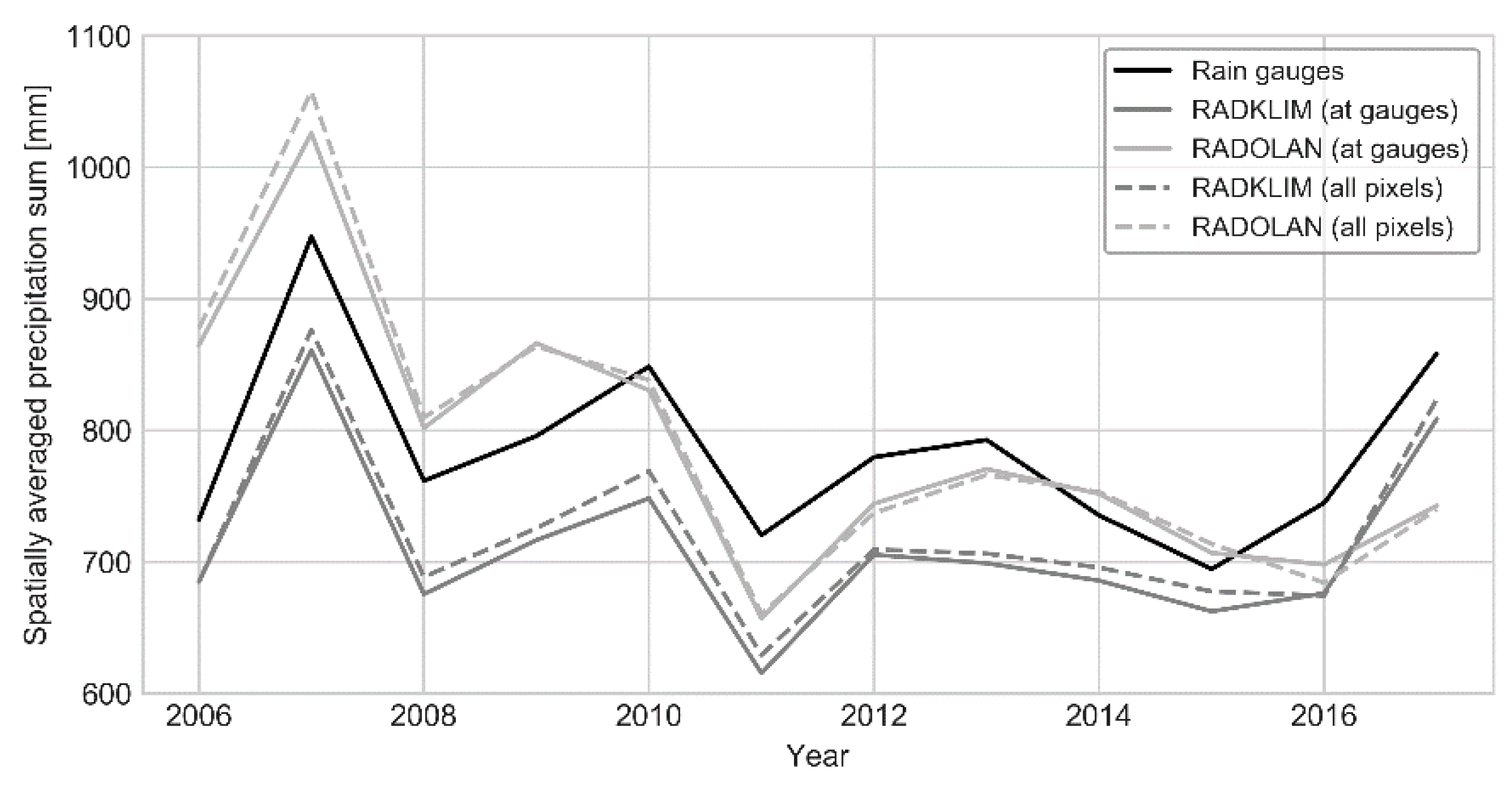
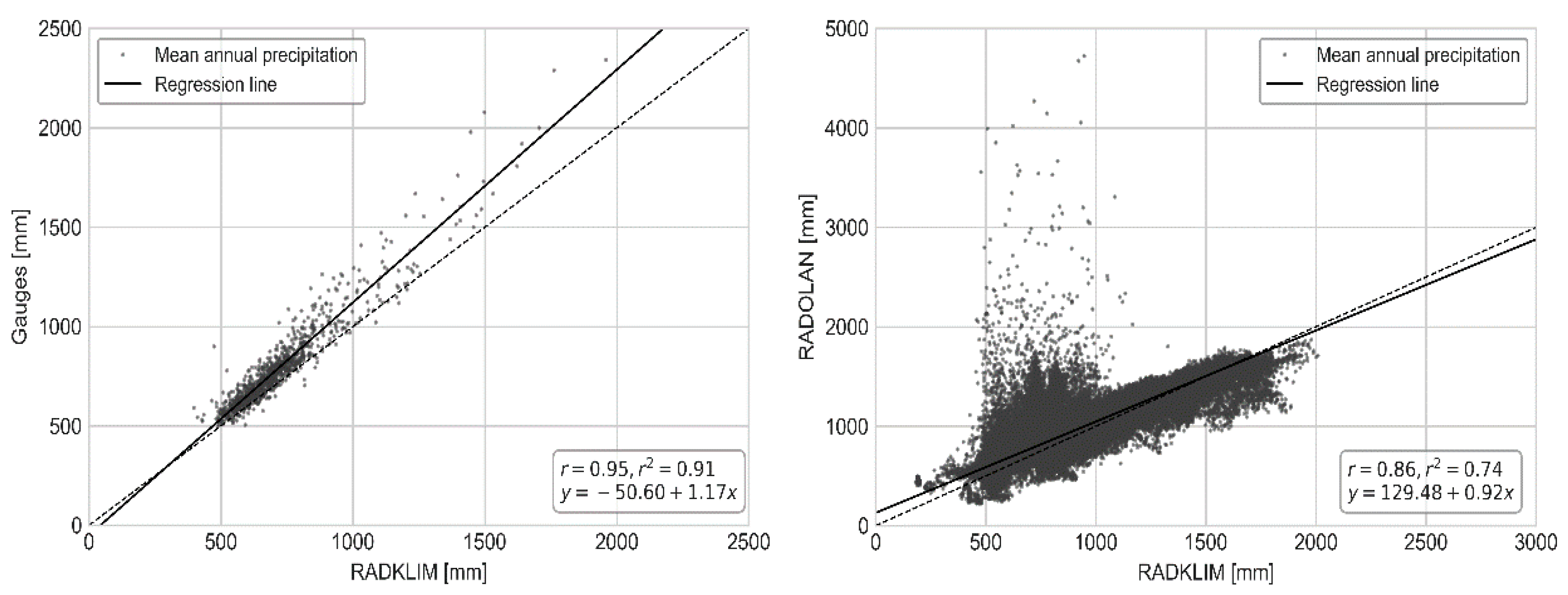
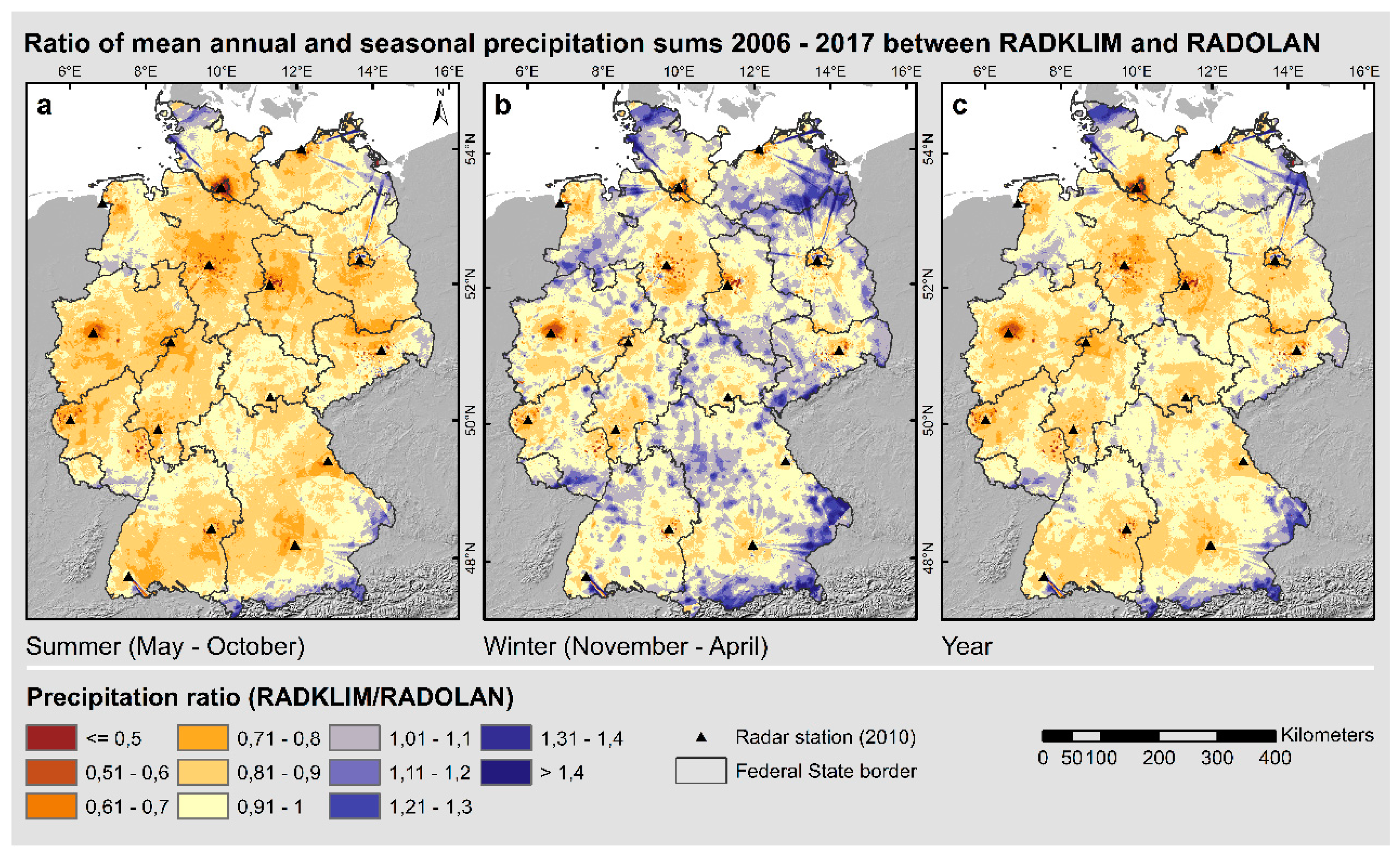
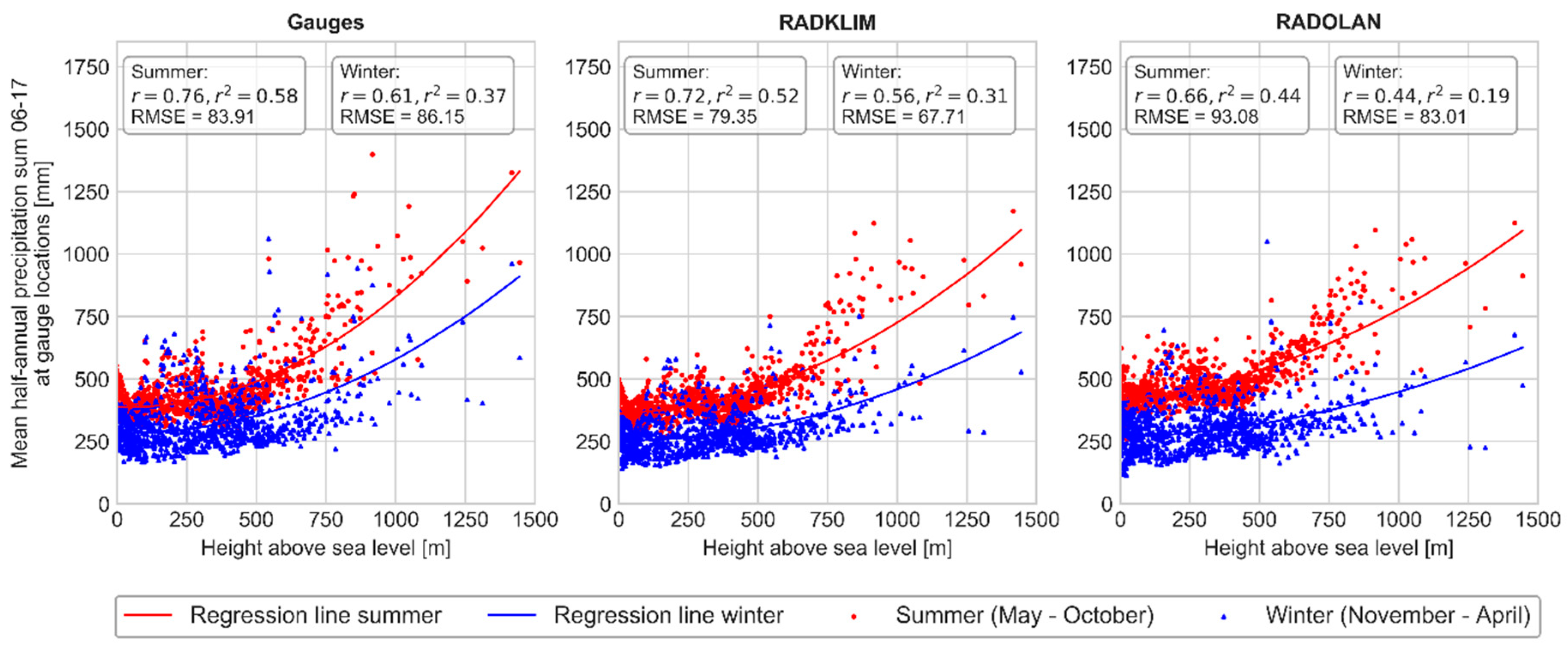
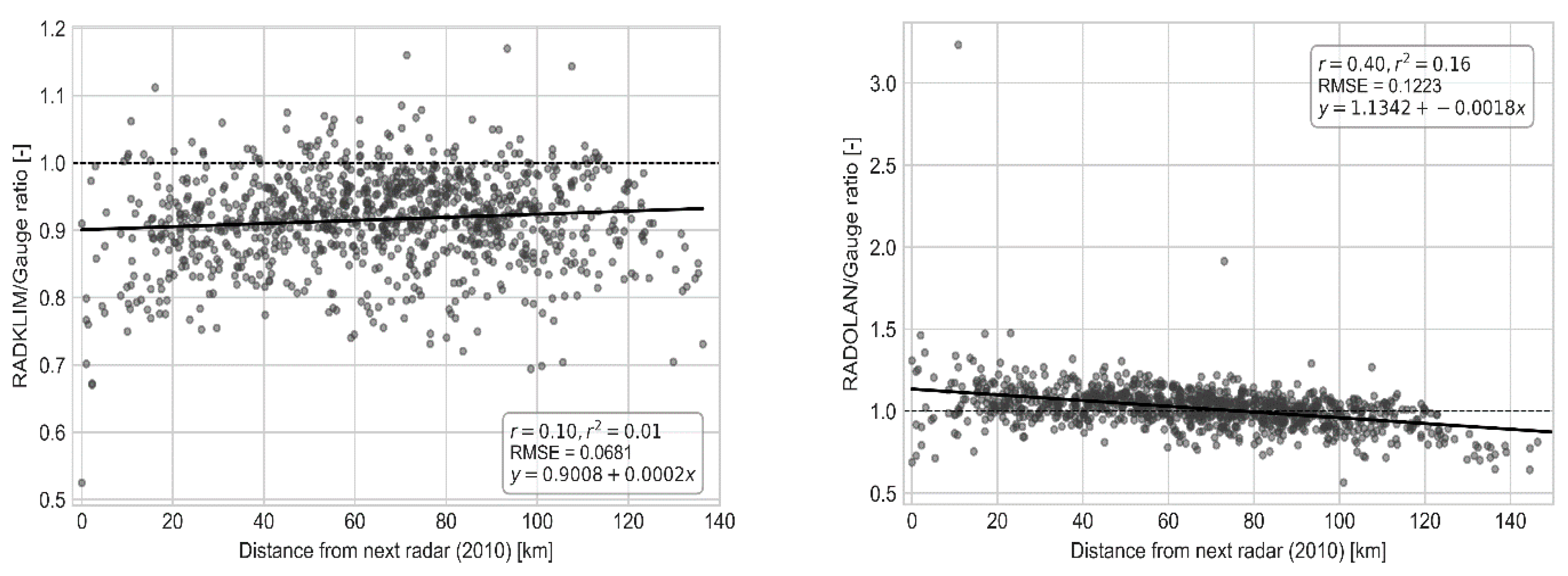
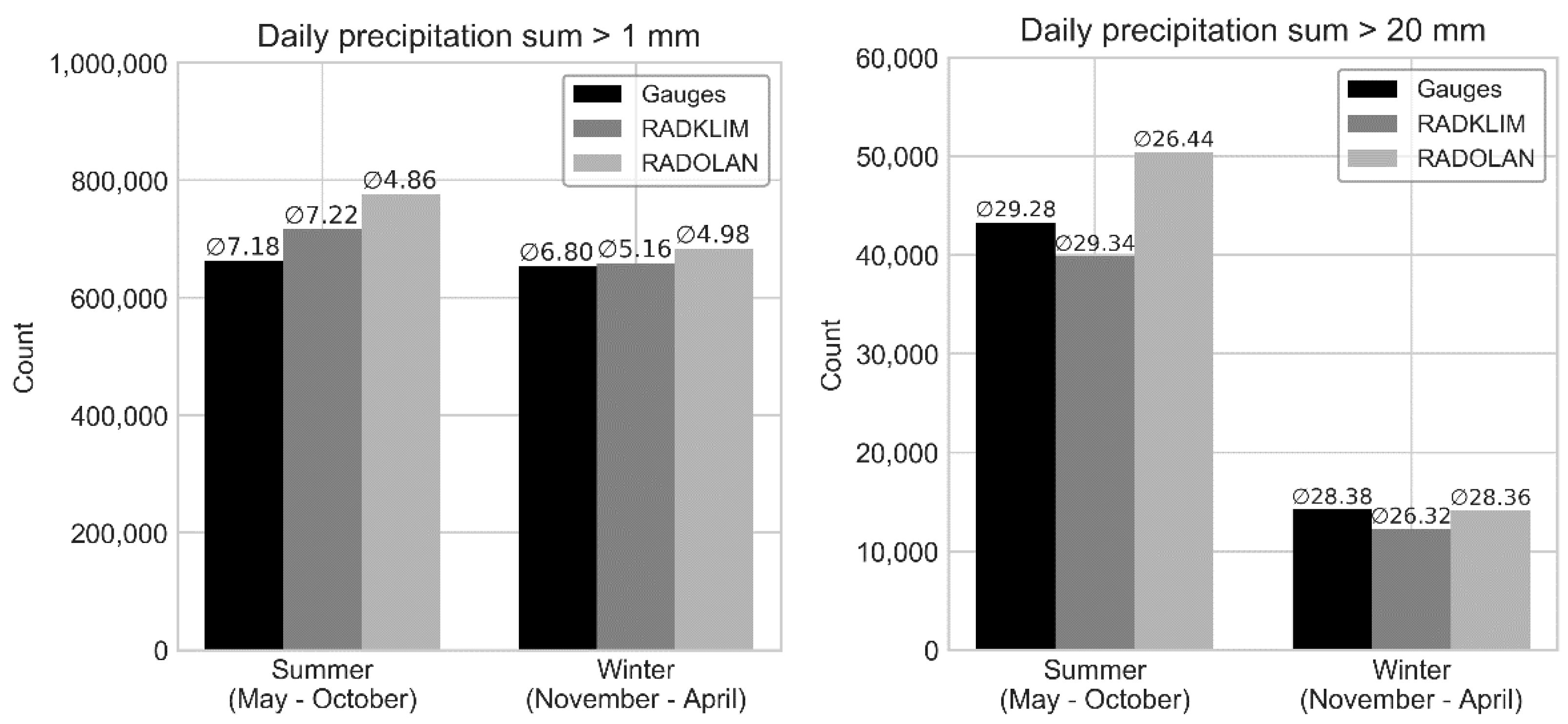
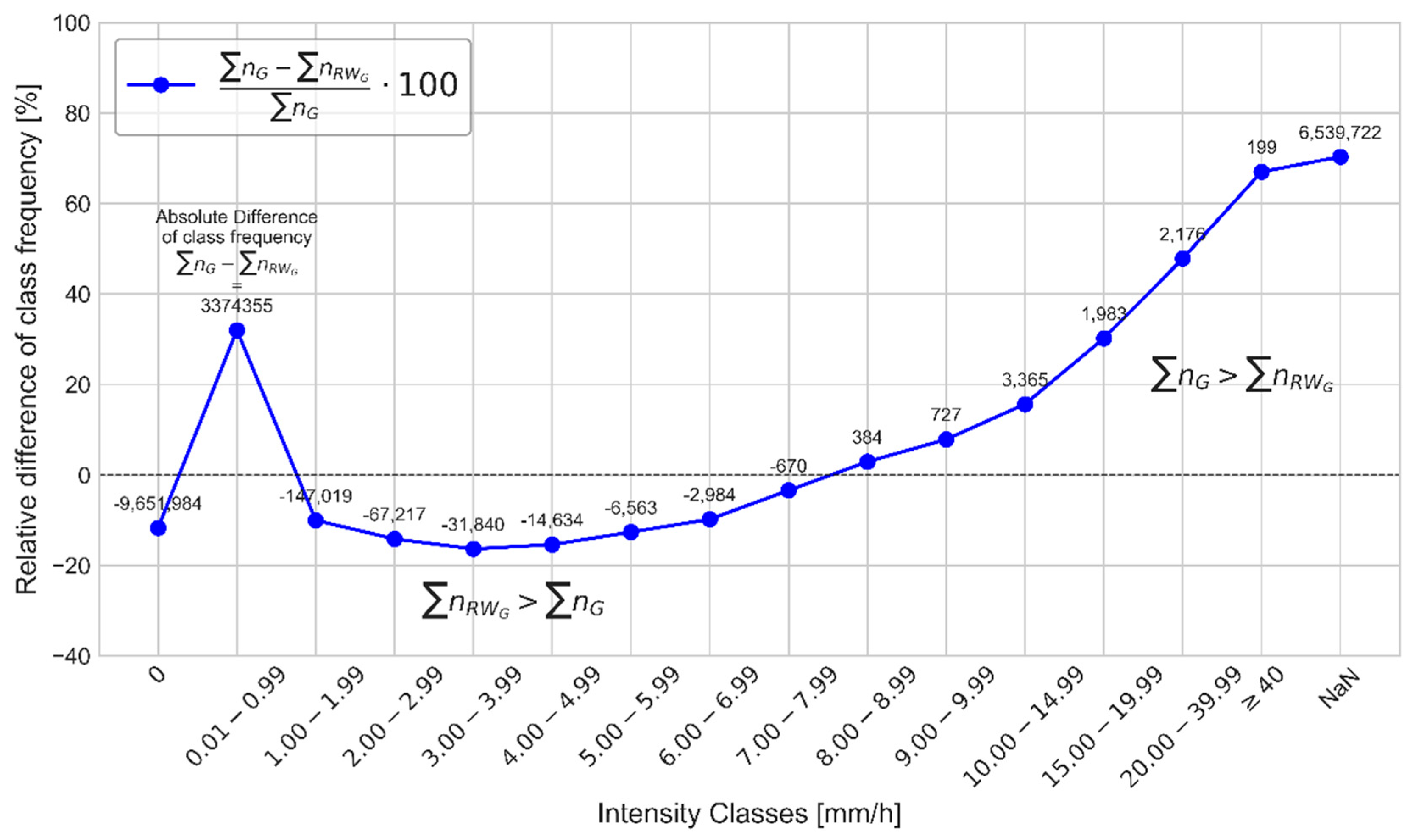
| Radar Product | Open Access | Time Period | Temporal Resolution [min] | Radar Radius [km] | National Grid [km] |
|---|---|---|---|---|---|
| RADKLIM RW | Yes | 2001–2018 | 60 | 128 | 1100 × 900 |
| RADKLIM YW | Yes | 2001–2018 | 5 | 128 | 1100 × 900 |
| RADOLAN RW | Yes | Since June 2005 | 60 | 125/150 | 900 × 900 |
| RADOLAN RY | No | Since June 2005 | 5 | 125/150 | 900 × 900 |
© 2020 by the authors. Licensee MDPI, Basel, Switzerland. This article is an open access article distributed under the terms and conditions of the Creative Commons Attribution (CC BY) license (http://creativecommons.org/licenses/by/4.0/).
Share and Cite
Kreklow, J.; Tetzlaff, B.; Burkhard, B.; Kuhnt, G. Radar-Based Precipitation Climatology in Germany—Developments, Uncertainties and Potentials. Atmosphere 2020, 11, 217. https://doi.org/10.3390/atmos11020217
Kreklow J, Tetzlaff B, Burkhard B, Kuhnt G. Radar-Based Precipitation Climatology in Germany—Developments, Uncertainties and Potentials. Atmosphere. 2020; 11(2):217. https://doi.org/10.3390/atmos11020217
Chicago/Turabian StyleKreklow, Jennifer, Björn Tetzlaff, Benjamin Burkhard, and Gerald Kuhnt. 2020. "Radar-Based Precipitation Climatology in Germany—Developments, Uncertainties and Potentials" Atmosphere 11, no. 2: 217. https://doi.org/10.3390/atmos11020217
APA StyleKreklow, J., Tetzlaff, B., Burkhard, B., & Kuhnt, G. (2020). Radar-Based Precipitation Climatology in Germany—Developments, Uncertainties and Potentials. Atmosphere, 11(2), 217. https://doi.org/10.3390/atmos11020217






